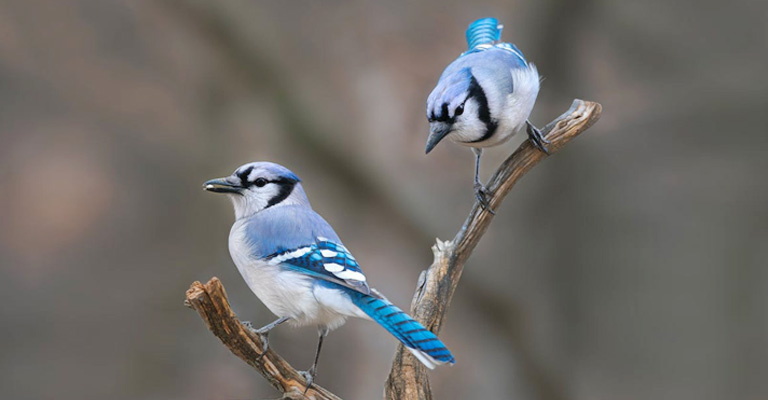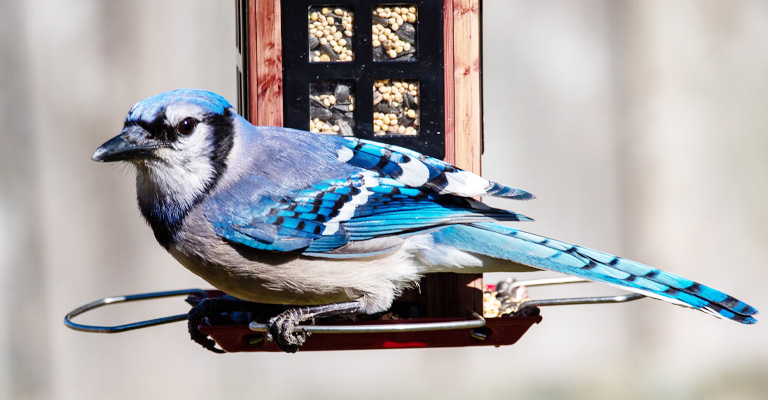So far, what we know about the blue jays is that, they are territorial and often not so friendly to other birds. But that entirely doesn’t mean they are fully wild.
They are quite popular for their beautiful blue crest with wide neck chest band. Additionally, they are also social with their own kind. If you are a bird lover, you must have given it a thought – to have one or two in your home.
Even many ornithologists are clear about the fact that blue jays are not entirely feral and if you put in a little bit of effort, you can tame them. You will start by attracting them first.
Can you do it on your own? Not a problem even if you can’t. You are just at the right place and let us help you today with, how to attract blue jays.

How to Attract the Blue Jays?
It starts by creating a suitable and inviting environment for the birds. Not just the blue jays, but any bird or animal who has been wandering freely in the wild won’t feel comfortable unless you offer them a welcoming environment.
Plants: Blue jays often nest in trees. You can have mature trees in your yard. Most Blue Jays are seen in oak trees, near the entertainment parks.
You can’t raise a tree in a day or two. But having a mature tree is a plus point. They also appreciate dense shrubbery for cover and foraging. In case big trees are out of your limit, you can plant a selective bush to attract them.
Water Source: Like any bird, blue jays must have access to fresh water. Especially during the cold winter, a reliable water source becomes hard for them to find. You can insert a fresh and warm (if manageable) water source for them in your backyard.
Since they are available all year round, you would need a heated birdbath. It will attract them often and they would come back to frequently drink and bath. Because they are among a few of the largest species of birds, go for a wide and deep birdbath.
You also have to focus on hygiene and regularly clean the bird bath, replacing the water.
Food Source: Blue Jays need a versatile diet. They are omnivorous and feed on different sources. Even though a large part of their diet comes from seeds, they also need protein to satisfy their nutritional needs.
We may not provide everything they need, but we can surely start with the list below,
Seeds: You can start with the basics: plant sunflowers, black oil sunflower seeds, and peanuts. They would love them.
Nuts: Offer unsalted peanuts in the shell or shelled nuts like almonds, pecans, and walnuts. Blue Jays can effortlessly crack the nuts and they love this act.
Fruits: They enjoy fruits like berries, grapes, and cherries. You can plant fruit-bearing trees or shrubs in your yard.
Insects: Blue Jays are fans of caterpillars, beetles, and grasshoppers. You can encourage insects but also avoid pesticides at the same time in your garden. The birds will appreciate a buffet of insects during the breeding season.
Suet: A smart but effective trick. You can hang suet feeders filled with suet cakes or homemade suet mixtures. Suet is a high-energy food source that blue jays love, especially in winter.
Go through the list again and figure out which one you can easily manage. It often depends on our capability and budget and it’s completely normal to prefer seed mix over suet.
At the end of the day, it’s your backyard and the blue jays would love any of the foods you offer them from here. Now, the question remains, how to offer the food to them? Let’s find out.
How to Offer Food to the Blue Jays?

You can set up different feeding stations in your backyard. Eventually, when they become a little more used to your appearance and environment, you can hand-feed them. You can start with,
Bird Feeders
Initially, you can use platform feeders or hopper-style feeders. It should have a flat surface for blue jays so that they can perch comfortably. Next, fill the feeders with their favorite seeds and nuts, and also ensure they can easily access the food.
Suet Feeders
Suet feeders equipped with cages or holders are ideal for offering suet cakes to blue jays. You can hang them from tree branches or hooks at different heights and make them suitable to match different bird sizes.
Ground Feeding
It’s one step ahead to bond with the birds. Blue jays often feed from the ground. You can scatter seeds, nuts, and fruits directly on the ground and wait for them. Don’t lose patience. This may take some time.
Now we know what to feed and how to offer them to attract the blue jays. Follow the few tips below to ensure proper hygiene and no harm to the birds at all.
A Few Additional Tips
You can learn a few more bird-friendly practices to safely get on board with the blue jays. They are,
- Don’t use pesticides or herbicides in your garden. It can harm the insects and other microbes essential for bluejays.
- You should keep your feeding stations and bird baths always clean. Stale water or spoiled food can affect blue jays and other birds.
- Outdoor cats are a significant threat to birds. A recent study shows that household cats kill about 2.4 billion birds each year. So, it is wise to keep the cats indoors and safe to restrict them entirely from the bird feeding zone.
Here it goes! You have now full knowledge of how to attract blue jays in your backyard. But don’t forget, it also takes a significant amount of patience and perseverance before they appear and reappear in your backyard. Be always friendly to them.
Want to Learn More?
Do you love birds and want to learn more? We are here for you. We share regular useful content on birds. Our articles will help you treat and nurture your feather friends better.
You can learn more from our blog section each day! Stay in touch with us and also, share our articles with your friends and other bird lovers. It will help us grow!